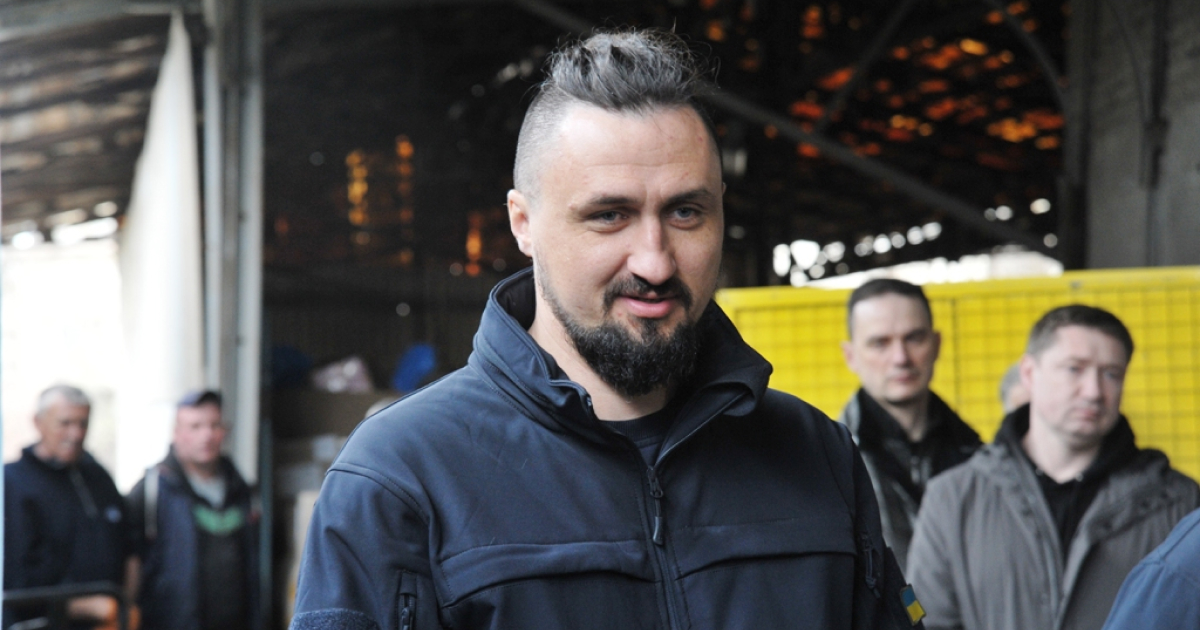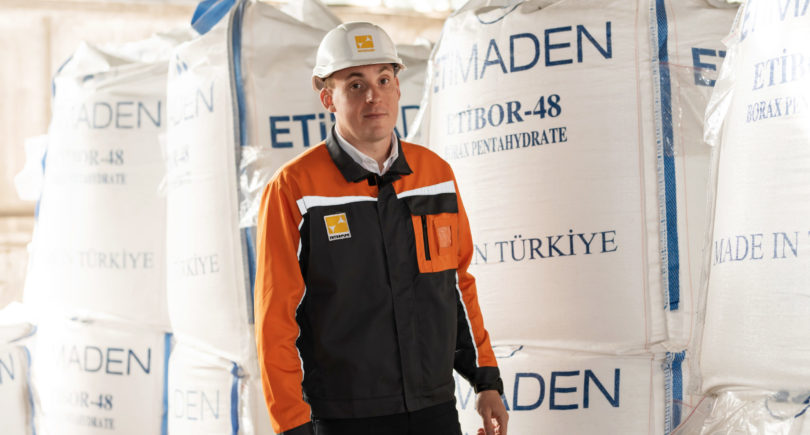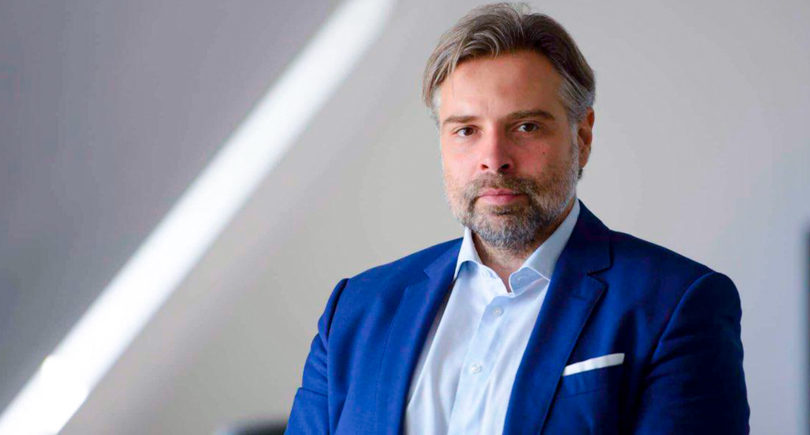
Interviews Ukrzaliznytsia 3824 11 April 2022
The Head of Ukrzaliznytsia about the work in the first months of the war and plans for cargo transportation
Ukrainian railways have been, and remain a key partner of the industry in solving logistical problems: transportation of coal, diesel fuel, grain, ore, finished steel products. Under the war Ukrzaliznytsia faced not only the humanitarian task of people evacuation, which successfully fulfilled, but also to ensure the running of economy. It was about freight traffic, and new logistical challenges, the potential of Ukrainian railways, and interaction with European colleagues that we talked with the Head of Ukrzaliznytsia Oleksandr Kamyshin.
What are the priorities of Ukrzaliznytsia for April? Is it possible to say that the restoration of freight traffic is becoming increasingly important?
The economy is our top priority right now. We were the first to come out with a program aimed at keeping the economy running. In the third week, the evacuation, and passenger flow began to decline, and we came out with the “Iron economy”, which consists of three directions. The first – “Iron terminal”, an expansion of the capacity of the western border crossings. The second is “Iron sowing time”. Here our task is to help farmers to catch up faster with the volumes of diesel, and fertilizers. The third is the relocation of business to the Ukrzaliznytsia sites within the state program.
The second direction was the most successful, and we worked well with the farmers. Even before the start of the war, we effectively rebuilt the diesel fuel procurement system, which has now become the basis for dynamic preparations for the sowing campaign. Business relocation is not in high demand. First, businesses need to stay where they are, providing jobs, and taxes in the region. Secondly, not every business can be effectively transported, as production chains are disrupted. I visited Trostyanets, Kharkov, spoke with the authorities, and business. No one will leave their city, and go away.
The No. 1 priority of UZ is the “debottlenecking” of the Western border crossings. We pay a lot of attention to them, we will make a presentation of new projects, and agreements with our European partners in the next 2-3 weeks.
What is your baseline scenario for logistics corridors?
I believe that we will win! It is the most important. Over time, the ports will return, the old logistics corridors will be restored. But now the railway is a key route. I would like to hope that as early as 2022 ports will return as a logistics corridor, although it is most likely better to talk about 2023. But Russia remains geographically close – therefore, reasonable entrepreneurs will begin to “beat a path to” safer corridors to the West, build terminals of different capacities. The main thing is that these terminals must have such a capacity that, in case of emergency, it can be increased by 5 times.
Will new investments in logistics infrastructure be on the western border of Ukraine?
For example, export of grain grows annually. And new capacities will appear not as before – in the South near the ports – but in the West. Moreover, this is not only Ukraine, not only a junction, these are European ports (Gdansk, Swinoujscie, ports of the Baltic countries), this is rolling stock there, in the EU. Now everyone in the EU understands that Ukraine needs help, to protect it. The main paradigm is the following: I tell the Europeans that, in addition to avoiding a supply crisis, they can earn money with us. We have millions of tons of cargo that will now go to you (in the EU) by rail. In the future we will provide 50 million tons of grain, over 20 million tons of ore. That is, 100 million tons of cargo from Ukraine can go through Europe!
What are the volumes of freight traffic today, and what are your plans for April-May?
In the first days of the war, they did not talk about cargoes at all. Then we reached 140 thousand tons per day on average. It is clear that the structure has changed, the volume of transportation of building materials has fundamentally decreased, especially for the construction, and repair of roads. The operational plan for April was 272 thousand tons per day, now we see that 300 thousand tons per day can be achieved on average. About May: I don’t look that far, we are planning, in fact, for days. We constantly change plans, and in a big way.
Recently, the management of Ukrzaliznytsia discussed with representatives of Metinvest, and ArcelorMittal Kryvyi Rih the resumption of freight traffic, interaction during the launch of ArcelorMittal Kryvyi Rih, and Zaporizhstal. What specific issues were discussed, and what actions will be taken to help resume full operation?
First, we help to rebuild the logistics of raw materials. For example, these are issues of new routes for the supply of limestone, and coking coal. The second is the development of new routes for the delivery of finished steel products. What used to go to the ports now needs to be redirected to the western border. For us, metallurgical plants, and mining and processing enterprises are very important customers, with them it is possible, and necessary to plan large-scale cargo flows for 2-3 years. But all this is not easy – to organize new routes, you need to see the western crossings with your own eyes, decide where the mobile transshipment will be, where the warehouse will be, where the cranes will be placed, etc. That is, a huge number of issues arise that need to be addressed anew by all participants in the supply chain.
With the lockdown of seaports, western railroad crossings remain the only gateway for large-scale exports. How do you assess the export (handling) volume, and what is the potential of this direction?
The potential is very big. In fact, only 3 transitions out of 10 are loaded for 100%. The rest are loaded for 30-50%. So the only question is the speed of restructuring logistics routes along the entire supply chain, and not just to the western border of Ukraine. For example, GOKs increase their logistics to the western border by almost 3 times in April compared to January. An increase of even 10 times is possible right now. Ukrzaliznytsia has a plan, and an understanding of the future at all crossings in western Ukraine. In particular, we took the Yagodin-Kovel junction, all the stations along it, and the existing terminals, and outlined promising sites. What can be done now, and in the future? We “rebuild” each station. In the second week of the war, I gave the command to restore the narrow gauge on the Kovel-Yagodin section (there is a narrow gauge on this entire section – all 70 km). We have already actually restored it – it is already “driving”, 15 km/h for now, but we will raise it to 25 km/h, and then to 40 km/h. Now it’s up to business – farmers, and other exporters should to establish mobile transshipment. In fact, this is an expansion without much investment. Today, 1/3 of the volume of grain, that can be transported, is transported.
What are the main bottlenecks, and restrictions in the logistics of western crossings today?
The first restriction is the readiness, and speed of business logistics to develop, and organize a new route through the western direction to European ports.
The second is the willingness to work with European partners. For example, some companies are faced with the fact that some terminal in Poland does not confirm the shipment to them until they see where they will take the cargo next. But in Ukraine, Ukrzaliznytsia also did not confirm until the port gave the go-ahead. That is, the principles of organizing freight traffic, and interaction of counterparties are the same everywhere, but we need to work out all the details, and start the work of the logistics chain anew.
The third problem is that the volatility of our ports and their work was huge, but this is not the case in the EU. No one was waiting for our freight traffic with free capacities. They do not have free rolling stock, there are no large free capacities in ports for our cargo. That is why we suggested to the Poles: let’s take our wagons, put them on narrow wheels, and they will work for you. The fundamental problem now is that everyone has directed their flows to 3 main junctions, and we propose to use everything. Therefore, we are preparing information on transitions, and capacities, and giving access to the Iron economy: there is data on all operating bulk, grain terminals, etc. with contacts. Everyone can use this information; we will soon prepare it in English for foreign partners. Ukrzaliznytsia is ready to be a “guide” in the new logistics.
How much has the Ukrzaliznytsia infrastructure suffered as a result of military actions? Is it necessary to restore the railway track?
We keep daily records in physical terms: kilometers, bridges, spans. We make approximate calculations, but not public ones. We are not ready now to make this information open to the public, it requires careful verification, and evaluation. This information will be ready after the end of the war. Regarding the restoration of the railway bed and rails: on the one hand, we have our own small reserves, on the other hand, we are ready to work with European manufacturers if necessary.
To what extent will the scheme of transport flows, and routes of Ukrzaliznytsia in the direction of Europe change after the war? Which European ports will be more promising for Ukraine?
We can ship to all European ports. The most promising are the ports of the Baltic countries. The ports of Poland, and Romania are already loaded, they work according to their plan. And the Baltic ports, which used to systematically serve Russian cargo, are the most promising for us, since these terminals served similar kinds, and types of cargo. That is, it is the ports of the Baltic countries that have the potential to receive our millions tons of grain, and ore for shipment around the world.
To what extent are partners in the EU ready for an increase in freight traffic from Ukraine (Poland, Hungary, Slovakia, Romania)?
The greatest mutual understanding, and readiness to meet now is with Poland. A couple of months before the war, we were already actively negotiating with our Polish colleagues, and now they are ready to introduce new routes with Ukraine. The example of passenger traffic is indicative: when it was necessary to organize evacuation, we were able to increase the flow at peak loads up to 20,000 from 300-500 passengers per day on Mostytskaya. The willingness of the Polish side to receive people played a key role. With the cargo flow, everything is not going so fast, but they help us a lot to organize logistics on their part.
Ukrzaliznytsia offers business its facilities for the relocation of production. Are there any companies interested in locating production facilities in these areas?
The business was not ready, a lot of equipment is simply impossible to dismantle, and take out. Lots of emotions. Business stays to the last in their locations. Most are waiting for the end of the war. This program “didn’t take off”, it happens. We are not afraid to try.
For example, we are launching a new project – luggage mail cars. This could be a driver for e- commerce and for industry, a new opportunity to carry out small batch logistics quickly and cheaply.
Moreover, we are now a key food transporter. At the beginning of April, we supplied more than 130 tons per day. This is an important, and complex process in which de jure Ukrzaliznytsia is the buyer, and carrier, and de facto the volumes, and prices of purchases are determined by the military administrations, and the Ministry of Agriculture, the Ministry of Energy, and the Ministry of Health, depending on the type of goods. That is, part of the freight cars is reserved for this need, and we work closely with manufacturers.
What are the prospects, and potential of cargo flows from Ukrzaliznytsia – is 100 million tons of cargo real?
At the moment, we are not ready to ship 100 million tons right now – this is our proposal for the whole world, for Europe. Ukraine has a potential of 100 million tons of cargo, let’s set things up together. Prepare, for example, Swinoujscie for 10 million tons to arrive there. We expect an increase in freight traffic due to the recovery of the economy after the war.
The second topic is risk differentiation. The business will deploy part of its cargo flows from the southern ports of Ukraine to the western direction in order to differentiate risks. Even when the war is over, it is better to have a working corridor of 10-20%, for example.
We are counting on an increase in shipments of grain and ore by tens of millions of tons in the future, and we will do our best to achieve this. In peacetime we were an economic artery, in wartime we became the road of life. But both in war and post-war times, we must also become an accelerator of the economy.




